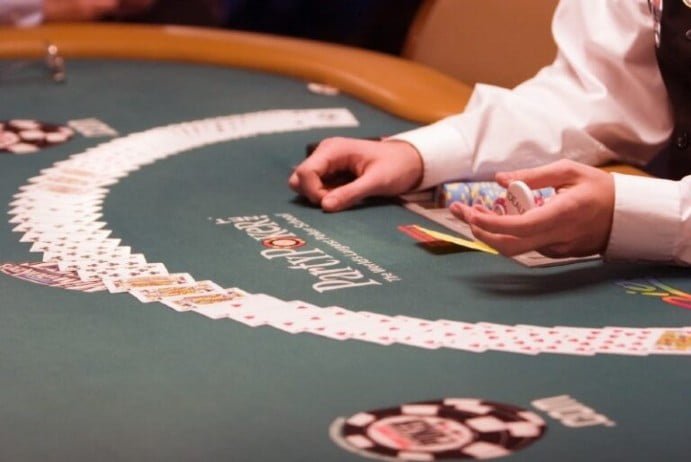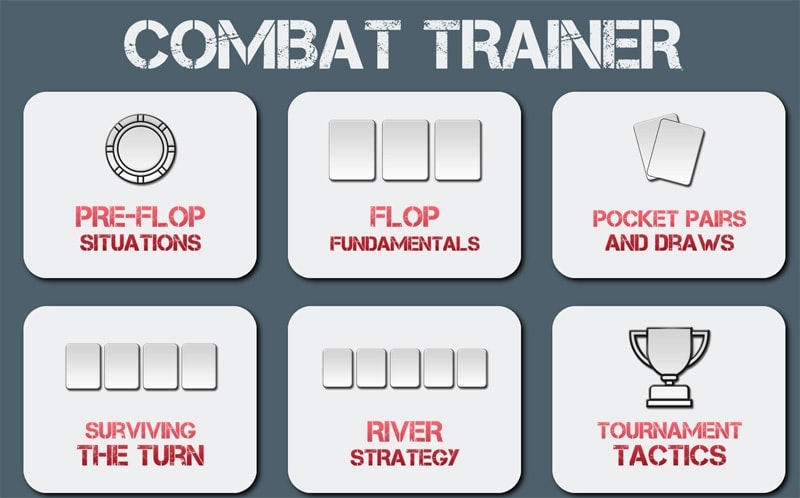Poker Tournament Strategy Middle Stages
- Online Poker Tournament Strategy
- Poker Tournament Strategy Middle Stages Pdf
- Poker Tournament Strategy Middle Stages 4
- Poker Tournament Strategy Middle Stages 2
Similarly, in satellite tournaments or Steps tournaments there is far more emphasis on a coming 1st and playing loosely. Big Stack, Mid Stack and Small Stack Strategy Play according to your stack size. Big stacks with over 30xBBs should play agressively and make use of blind-steals, squeeze play and bluffing. List of discussions in the Tournament Poker section, which is a part of the Poker Strategy category at Cardschat.com. The Tournament Poker forum has discussion on: Discuss both online and live.
- Early stage poker tournament strategy tips; Let’s get started. Chips you win are worth less than the chips you lose. The fact that tournament chips don’t have a monetary value is the main factor that differentiates pre-ante tournament play from cash games—even if the stack sizes in.
- Pre-Tournament Game. Often overlooked, pre-game is one of the most important parts of a winning.
- Understanding the Early, Middle, and Late Stages. Any player can win a poker tournament by simply getting the perfect cards at the right time, or when playing against awful poker players. All of us know that the best tournament poker strategy is aggression. This is especially true with an online poker tournament strategy.
888 Poker has one of the easiest to beat player pools. Don't join the sharks on PokerStars, play where the real fish are!
>>Beat the Fish at 888 Poker Now!<<Late Stage Tournament Strategy

Your strategy needs to be related to where you want to finish. You can play tight-agressive (TAG) for an ITM finish.
If you’re playing to win however you’ll need to play more loose-agressive (LAG) and take bigger risks, for example, shoving pocket pairs early.
In small tournaments e.g. Full Tilt’s 180 man MTTs, I always recommend a LAG approach – mostly because the prizes are so top heavy. Similarly, in satellite tournaments or Steps tournaments there is far more emphasis on a coming 1st and playing loosely.
Big Stack, Mid Stack and Small Stack Strategy
Play according to your stack size. Big stacks with over 30xBBs should play agressively and make use of blind-steals, squeeze play and bluffing. You need to bully small stacks sitting on the blinds and don’t be afraid to call them down pre-flop when you’ve got a marginal hand like suited connectors or high Ace.
Mid stack players with a stack between 15 – 30BBs need to play slightly tighter than a deep stack but still bully small stack players take advantage of other tight players in the same position. You shouldn’t be pre-flop shoving so much from early position without quality hands, but stealing and re-stealing is still really important. Most action should come from mid-late position and very importantly you need to avoid becoming pot-committed against deep stack opponents. There are more cost effective ways to build chips then getting into pre-flop coinflips vs chip leader.
Let’s be honest – small stack players need a miracle at this point. If you have less than 10xBBs than you really need to be jamming your top 50% of hands as early as possible. This article moving all-in as a short stack is a good read – it identified what hands to move all-in with. Most of your game at this point will depend on luck and taking big risks.
Keep Stealing/Defending the Blinds
The value of blinds (and antes) is massive and that makes pre-flop pots important to steal.
I try to steal the blinds as often as possible from position and take advantage of tight/weak players on the blinds. As long as you’re raising or bluffing with hands that have “outs” (suited connectors for example) you can still get called and hit a monster.
Defending blinds needs to be adressed. To defend blinds properly you need to be re-raising or folding to loose opponents. Calling is a big No No because you’re totally out of position and it’s very unlikely you’ll can catch up. Read playing/defending blinds for more details.
Our Top Recommended Tournament Site:
Sign up now and get a $1100 Bonus
Using a Poker HUD on the Final Table
Well-timed aggression and a poker HUD is essential to beat the final table. You gotta know what your opponents are 3betting or re-raising with and their positional hand range. I honestly believe poker tools are the most important factor to the outcome of your play. A successful player using a strong tool like HUD or Poker Office will be better equipped to break down their opponent’s style and shoving hands.
Most pots will go down pre-flop because of the size of the blinds and antes. This leaves little room for what I call “real poker” and your advantage at this stage will come from knowing players’ starting hand ranges and 3bet hands.
Look for the Best MTT Poker Sitesrecommended by our site.
Play Where US Players are Welcome!BetOnline Accepts players from the USA, and has soft games compared to Pokerstars and Full Tilt.
>>Play at BetOnline Now (US Players Accepted)!<<Related articles:
Leave a Reply
- $400
- $2000
T&C apply to bonus offerings
(This article is a follow up to 'Early Stages Tournament Strategy')
If you have played well enough to reach the middle stages of a tournament then your strategy has worked well so far. At this point you most likely have one of three possible chip stacks: a short stack, an average stack, or a big stack. Each of these stacks requires a different strategy to adapt to the increasing blinds and antes.
This article will teach you how to play each stack during the middle stages. The most important part of any tournament is the middle stages, because blinds and antes finally start placing pressure on players, and the players who succeed now will have the best chance to reach the money.
We consider the middle stages as starting when half of the original player field remains, and lasting until the tournament reaches the bubble.
Playing the Short Stack in the Middle Stages
Now that you are in the middle stages of the tournament, blinds are pretty significant in relation to the average stack, and antes have most likely kicked in. Short stacks are in for some tough times because the blinds will put the most pressure on their smaller chip stacks. We consider your stack 'short' if you have less than twenty big blinds.
With a short stack you have very limited options, and your position at the table will dictate most of your plays. If you are in early or middle position, you cannot play a hand unless you are willing to commit your entire stack to the hand. The worst play you can make as a short stack is to raise in early position with a mediocre hand, then have to fold to a re-raise: it's just giving money away.
In late position you have a few more options, including the steal or the re-steal. To steal the blinds, wait until you are in late position and everyone folds to you. With less than ten big blinds you need to go all-in, but with more than ten big blinds you can make a standard 3x raise and hope that the rest of the players fold. If you can pick up the blinds/antes once per round you will be in good shape.
To re-steal, wait until another player with a medium or large stack makes a play at the blinds (you have to be behind the player who is stealing). After he/she raises, push all of your chips in. Most raises at this point will be with marginal hands, so your re-raise should scare most players off. If you can re-steal once in a while you will be able to build your stack, because you win much more than just the blinds/antes.
NOTE - You should only re-steal when you have enough chips to make a substantial re-raise. If someone raises to 400 chips, and you only have 800 chips, you cannot re-steal because your 400 chip re-raise isn't enough money to scare anyone away. Also, never re-steal against another short stack because they are liable to call off the rest of their stack with any two cards.
By stealing and occasionally re-stealing pots, you will be able to build back up to an average stack.
Playing the Average Stack in the Middle Stages
We consider an average stack during the middle stages as any stack with 20-50 big blinds. A player with an average stack has quite a few more options than a player with a short stack. We recommend following the same approach to stealing and re-stealing (target average-large stacks, and don't get too aggressive) but you also can add a few more plays to your playbook: the squeeze play and postflop play.
Online Poker Tournament Strategy
To make a squeeze play, wait until you are in late position and an early position player makes a small-average sized raise. If a few other players call, go ahead and make a substantial re-raise (regardless of your cards). Since no one has shown any true aggression in the hand, you can bet that most players have mediocre hands like AJ or a small pocket pair, and will fold to your re-raise. Squeezing can win you a ton of chips, because between the blinds, antes, and the other players' calls, there is a lot of money in the pot.
Make sure to only squeeze against other average-big stacks. If a short stack calls a raise and has half of their chips in the middle, it is unlikely that they will fold to a squeeze play because they are already pot committed.
Also, with an average stack you can see a few flops and try to outplay your opponent later in the hand. If you are in late position feel free to call a raise or two with solid hands, and see what the flop brings. Don't get too aggressive, but if you call a raise and smash a flop you can slow play your way to a huge stack.
Playing the Big Stack in the Middle Stages
Big stacks have two options for playing the middle stages of the tournament:
- They can follow the advice listed above for middle stacks, which will protect their stack and let them gradually accumulate chips for the bubble.
- They can go into 'bulldozer' mode and try to build an enormous stack.

Option #2 is a little more risky, as there is a chance someone will finally stand up to you and take a lot of your chips, but it can also allow you to completely dominate a table for extended periods of time.
Poker Tournament Strategy Middle Stages Pdf
To go into 'bulldozer' mode, make sure to raise almost any hand in late position, re-steal as much as you possibly can, and generally put as much pressure on the rest of the table as you can. If no one else has a big chip stack at your table, there is little risk of actually going bust, and the potential reward is that you become one of the tournament's chip leaders going into the bubble.

Poker Tournament Strategy Middle Stages 4
Now that you know how to play the late stages, learn how to play the bubble.